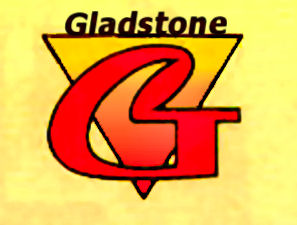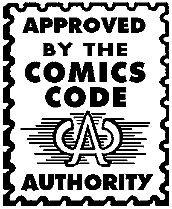
Howard Larsen was an American comic book illustrator for EC Comics and other publishers during the 1940s and 1950s.

Howard Larsen was an American comic book illustrator for EC Comics and other publishers during the 1940s and 1950s.
Specializing in crime and Western stories, Larsen contributed to several comics publishers, including American (Spy-Hunters), Avon (Romantic Love, Slave Girl, Wild Bill Hickok), Charlton Comics (Marvels of Science), Et-Es-Go (Suspense), Fiction House (Jungle Comics, Planet Comics , Wings Comics ), Novelty (Blue Bolt), St. John Publications (The Texan) and Victory (X-Venture).
His stories for EC were in Crime Patrol #11 ("The Werewolf's Curse!"), Crime Patrol #12 ("The Hanged Man’s Revenge"), The Vault of Horror #21 ("That’s a ‘Croc’!") and Tales from the Crypt #26 ("The Borrowed Body"). [1]

Gladstone Publishing was an American company that published Disney comics from 1986 to 1990 and from 1993 to 1998. The company had its origins as a subsidiary of Another Rainbow Publishing, a company formed by Bruce Hamilton and Russ Cochran to publish the Carl Barks Library and produce limited edition lithographs of Carl Barks oil paintings of the Disney ducks. The name references Gladstone Gander.
Entertaining Comics, more commonly known as EC Comics, was an American publisher of comic books, which specialized in horror fiction, crime fiction, satire, military fiction, dark fantasy, and science fiction from the 1940s through the mid-1950s, notably the Tales from the Crypt series. Initially, EC was owned by Maxwell Gaines and specialized in educational and child-oriented stories. After Max Gaines' death in a boating accident in 1947, his son William Gaines took over the company and began to print more mature stories, delving into genres of horror, war, fantasy, science-fiction, adventure, and others. Noted for their high quality and shock endings, these stories were also unique in their socially conscious, progressive themes that anticipated the Civil Rights Movement and dawn of 1960s counterculture. In 1954–55, censorship pressures prompted it to concentrate on the humor magazine Mad, leading to the company's greatest and most enduring success. Consequently, by 1956, the company ceased publishing all of its comic lines except Mad.

The Comics Code Authority (CCA) was formed in 1954 by the Comics Magazine Association of America as an alternative to government regulation. The CCA allowed the comic publishers to self-regulate the content of comic books in the United States. The code was voluntary; there was no law requiring its use, although some advertisers and retailers looked to it for reassurance. Some publishers including Dell, Western, and Classics Illustrated never used it. Its code, commonly called "the Comics Code", lasted until the early 21st century. The CC formation followed a series of Senate hearings and the publication of psychiatrist Fredric Wertham's book Seduction of the Innocent.

Gemstone Publishing is an American company that publishes comic book price guides. The company was formed by Diamond Comic Distributors President and Chief Executive Officer Steve Geppi in 1994 when he bought Overstreet.

Erik J. Larsen is an American comic book artist, writer, and publisher. He currently acts as the chief financial officer of Image Comics. He gained attention in the early 1990s with his art on Spider-Man series for Marvel Comics. In 1992 he was one of several artists who stopped working for Marvel to found Image Comics, where he launched his superhero series Savage Dragon – one of the longest running creator-owned superhero comics series – and served for several years as the company's publisher.
Mainline Publications, also called Mainline Comics, was a short-lived, 1950s American comic book publisher established and owned by Jack Kirby and Joe Simon.

The Vault of Horror was an American bi-monthly horror comic anthology series published by EC Comics in the early 1950s. Along with Tales from the Crypt and The Haunt of Fear, it formed a trifecta of popular EC horror anthologies. The Vault of Horror hit newsstands with its April/May 1950 issue and ceased publication with its December/January 1955 issue, producing a total of 29 issues.

The Haunt of Fear was an American bi-monthly horror comic anthology series published by EC Comics, starting in 1950. Along with Tales from the Crypt and The Vault of Horror, it formed a trifecta of popular EC horror anthologies. The Haunt of Fear was sold at newsstands beginning with its May/June 1950 issue. It ceased publication with its November/December 1954 issue, compiling a total of 28 issues.

Crime SuspenStories was a bi-monthly anthology crime comic published by EC Comics in the early 1950s. The title first arrived on newsstands with its October/November 1950 issue and ceased publication with its February/March 1955 issue, producing a total of 27 issues. Years after its demise, the title was reprinted in its entirety, and four stories were adapted for television in the HBO's Tales From The Crypt.

Tales from the Crypt was an American bi-monthly horror comic anthology series published by EC Comics from 1950 to 1955, producing 27 issues. Along with its sister titles, The Haunt of Fear and The Vault of Horror, Tales from the Crypt was popular, but in the late 1940s and early 1950s comic books came under attack from parents, clergymen, schoolteachers and others who believed the books contributed to illiteracy and juvenile delinquency. In April and June 1954, highly publicized congressional subcommittee hearings on the effects of comic books upon children left the industry shaken. With the subsequent imposition of a highly restrictive Comics Code, EC Comics publisher Bill Gaines cancelled Tales from the Crypt and its two companion horror titles, along with the company's remaining crime and science fiction series in September 1954.

Shock SuspenStories was part of the EC Comics line in the early 1950s. The bi-monthly comic, published by Bill Gaines and edited by Al Feldstein, began with issue 1 in February/March 1952. Over a four-year span, it ran for 18 issues, ending with the December/January 1955 issue.

The term adult comics typically denotes comic books, comic magazines, comic strips or graphic novels with content of an erotic, violent, or sophisticated nature marketed by publishers toward adult readers. They are sometimes restricted to purchase by legal adults, especially erotic comics which include sexually explicit material.

John Thomas Alexis Craig, was an American comic book artist notable for his work with the EC Comics line of the 1950s. He sometimes used the pseudonyms Jay Taycee and F. C. Aljohn.
The Association of Comics Magazine Publishers (ACMP) was an American industry trade group formed in the late 1940s to regulate the content of comic books in the face of public criticism during that time. It was a precursor to the Comics Magazine Association of America, and the ACMP Publishers Code served as the template for a more detailed set of rules enforced by the CMAA's Comics Code Authority.

Crime comics is a genre of American comic books and format of crime fiction. The genre was originally popular in the late 1940s and early 1950s and is marked by a moralistic editorial tone and graphic depictions of violence and criminal activity. Crime comics began in 1942 with the publication of Crime Does Not Pay published by Lev Gleason Publications and edited by Charles Biro. As sales for superhero comic books declined in the years after World War II, other publishers began to emulate the popular format, content and subject matter of Crime Does Not Pay, leading to a deluge of crime-themed comics. Crime and horror comics, especially those published by EC Comics, came under official scrutiny in the late 1940s and early 1950s, leading to legislation in Canada and Great Britain, the creation in the United States of the Comics Magazine Association of America and the imposition of the Comics Code Authority in 1954. This code placed limits on the degree and kind of criminal activity that could be depicted in American comic books, effectively sounding the death knell for crime comics and their adult themes.

The EC Archives are an ongoing series of American hardcover collections of full-color comic book reprints of EC Comics, published by Russ Cochran and Gemstone Publishing from 2006 to 2008, and then continued by Cochran and Grant Geissman's GC imprint (2011–2012), and finally taken over by Dark Horse in 2013.

Horror comics are comic books, graphic novels, black-and-white comics magazines, and manga e.g. focusing on horror fiction. In the US market, horror comic books reached a peak in the late 1940s through the mid-1950s, when concern over content and the imposition of the self-censorship Comics Code Authority contributed to the demise of many titles and the toning down of others. Black-and-white horror-comics magazines, which did not fall under the Code, flourished from the mid-1960s through the early 1980s from a variety of publishers. Mainstream American color comic books experienced a horror resurgence in the 1970s, following a loosening of the Code. While the genre has had greater and lesser periods of popularity, it occupies a firm niche in comics as of the 2010s.
Russ Cochran was a publisher of EC Comics reprints, Disney comics ,and books on Hopalong Cassidy, Chet Atkins, Les Paul, and vacuum tubes. He was a publisher for over 30 years, after quitting his job as a physics professor.
Fred Peters was an American animator and comics artist who contributed to several EC Comics. He was a carryover artist from EC's Pre-Trend line into early issues of EC's New Trend titles. He helped make many good comics, and people at his work said that he was a brilliant drawer and that he often made masterpieces of art.
Henry C. Kiefer was an American artist from the Golden Age of Comic Books. Best remembered for his contributions to the long-running comic book series Classics Illustrated, Kiefer was a prolific artist who drew features for just about every publisher of his era.